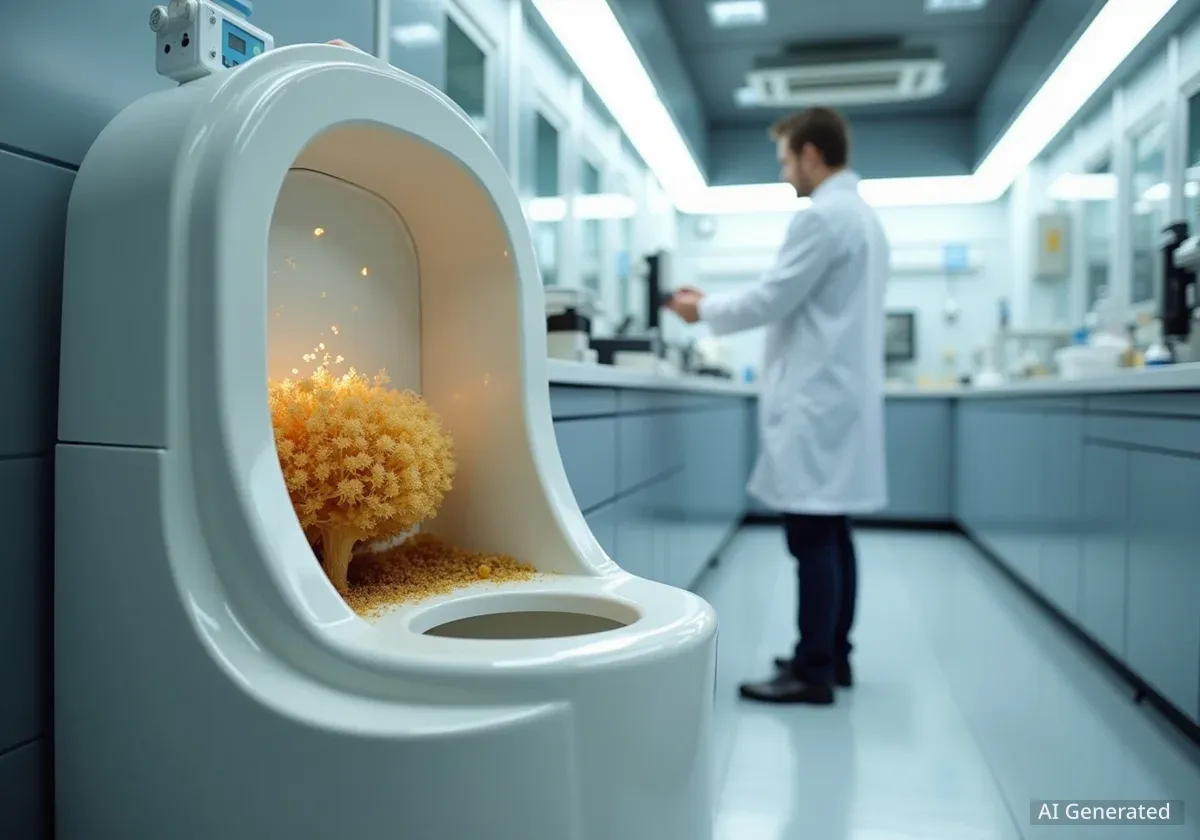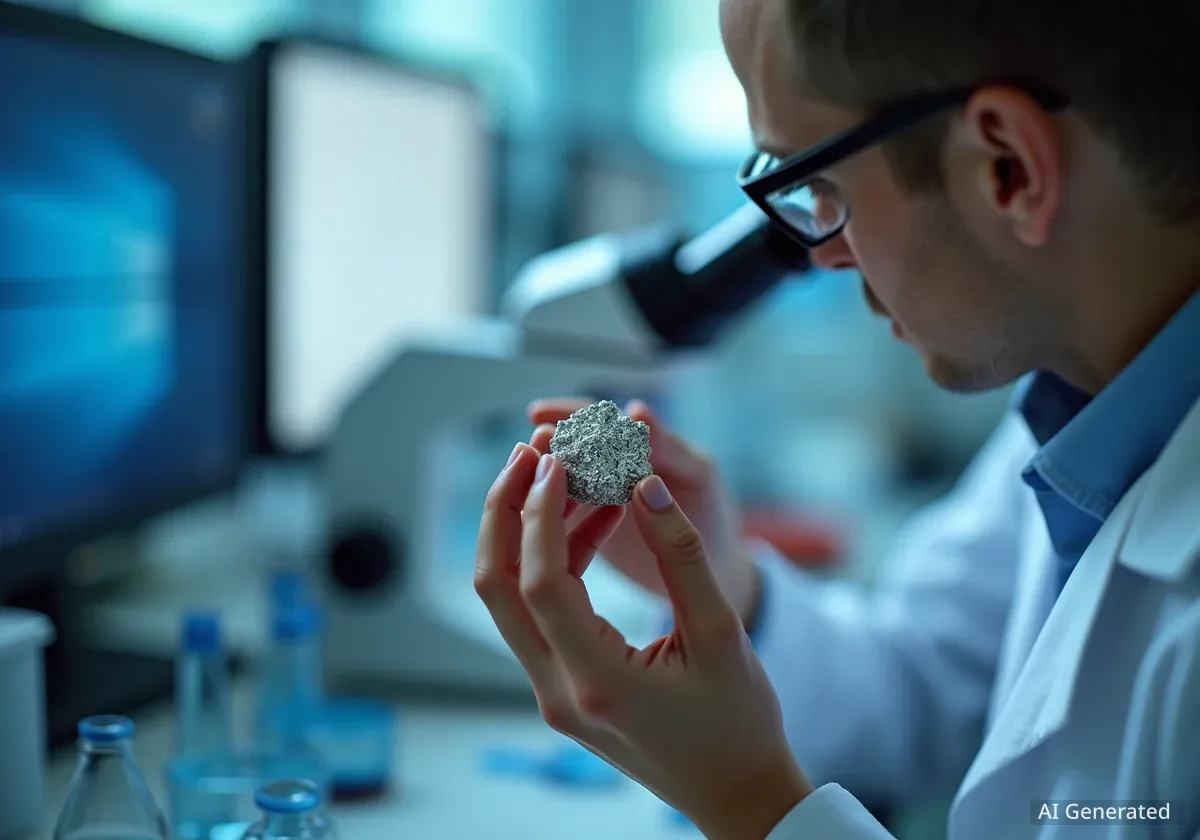Researchers at the University of British Columbia (UBC) have developed a novel waterless toilet that uses the root network of mushrooms to convert human waste into compost. The project, known as the MycoToilet, aims to provide a sustainable and low-odor sanitation solution that could be deployed globally.
The system is currently undergoing a six-week trial at the UBC Botanical Garden. It is designed to transform waste into usable soil and liquid fertilizer, offering an alternative to traditional wastewater treatment methods.
Key Takeaways
- The MycoToilet is a waterless system that uses mushroom mycelium to decompose human waste.
- Lab tests show the mycelium liner absorbs 90% of odor-causing compounds.
- The toilet is designed to produce approximately 600 liters of soil and 2,000 liters of liquid fertilizer annually.
- The project aims to address global sanitation challenges, as 3.4 billion people lack safely managed sanitation.
A New Approach to Sanitation Technology
Researchers from UBC's microbiology and architecture departments have collaborated to create what they call the world's first mushroom-powered toilet. The self-contained unit, housed in a cedar-sided structure, separates liquid and solid waste at the source.
The solid waste is directed into a compartment lined with mycelia, the vegetative part of a fungus consisting of a network of fine white filaments. This biological liner is the core of the toilet's innovative technology.
Joseph Dahmen, an associate professor at UBC’s school of architecture and the project's lead, explained that the team wanted to challenge the negative perceptions often associated with composting toilets. Odor is a primary concern for users.
"We really wanted to use the design to recontextualize an activity that we often take for granted and do without thinking, to kind of put it in a new light," Dahmen stated.
The goal was to create a system that is not only sustainable but also provides a pleasant user experience. Dahmen noted that one user described the toilet as similar to a Scandinavian sauna, a testament to its unique design and low odor.
The Science of Mycelium Decomposition
The effectiveness of the MycoToilet hinges on the natural properties of mycelium. Steven Hallam, a professor in UBC's department of microbiology and immunology, explained the scientific basis for using the fungal network.
"We have learned that the breathable mycelium liner can reduce odour, while removing residual moisture, limiting the onset of anaerobic conditions and creating more favourable conditions for aerobic decomposition," Hallam said.
How the Mycelium Liner Functions
The process leverages the natural relationship between fungi and tree roots in forests, where fungi help trees absorb nutrients and protect them from pathogens. In the MycoToilet, the mycelium performs several key functions:
- Odor Absorption: Lab tests have confirmed the liner absorbs 90% of odor-causing compounds.
- Moisture Control: It removes residual moisture, which prevents the anaerobic conditions that lead to unpleasant smells.
- Aerobic Decomposition: By managing moisture and allowing air to circulate, it promotes efficient, odor-free breakdown of solid waste.
The installation at the UBC Botanical Garden serves as a "living laboratory." Researchers will analyze the performance of the liner over the six-week trial using DNA barcoding methods to monitor pathogen loads and optimize the system.
MycoToilet by the Numbers
- 90% reduction in odor-causing compounds.
- 4 maintenance visits required per year.
- 600 liters of soil produced annually (estimated).
- 2,000 liters of liquid fertilizer produced annually (estimated).
"Everyone who's using that toilet is also engaged in citizen science effectively," Hallam added. The ultimate hope is that the entire liner can be converted into usable compost for the botanical garden and other local ecosystems.
From Waste Product to Valuable Resource
A central theme of the MycoToilet project is to reframe human waste not as a problem to be disposed of, but as a source of valuable nutrients. Dahmen noted that most people are unaware of what happens to their waste after they flush a conventional toilet.
Traditional wastewater treatment infrastructure, while vital, releases treated liquid effluents into rivers and streams. This process loses valuable nutrients like nitrogen and phosphorus that could be used to enrich soil.
"It's probably time to rethink some of those with new conceptual frameworks, so that we approach it not as waste, but as a source of nutrients that are valuable and can contribute to local ecosystems," said Dahmen.
Hallam agreed, stating there is a growing movement to view wastewater treatment facilities as "waste resource recovery systems." This shift in perspective is crucial for developing a more circular economy.
"Waste is a function of our values, and if we can rethink what we value in this context, there's lots of useful material in these effluents, and we can recover that, then we're adding value back," Hallam explained.
Addressing a Global Sanitation Need
The potential applications for the MycoToilet extend far beyond a university campus. The research team envisions this technology playing a role in addressing sanitation crises in underserved communities and lower-income countries.
The Global Sanitation Gap
According to a recent report from the World Health Organization (WHO), progress in sanitation is lagging. The report highlights that 3.4 billion people around the world still lack access to safely managed sanitation services. This gap puts them at higher risk of disease and social exclusion.
The MycoToilet's modular, waterless, and low-maintenance design makes it a potentially viable solution for areas without access to complex sewage infrastructure. By converting waste into fertilizer on-site, it could also support local agriculture.
The structure itself is built with prefabricated timber panels and features a skylight and a green roof planted with local flora. A low-power fan maintains air circulation, ensuring a comfortable environment. The current prototype is a step toward developing a scalable model that could be deployed where it is needed most.





